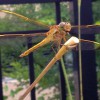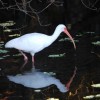 Simply designating open space in a development is not enough to provide long-term protection for a variety of wildlife. New policies need to be developed that encourage developers of conservation developments to adopt long-term management practices that support biodiversity conservation. This 5-page fact sheet discusses policy options that could be used to support conservation management practices and reports on a survey of Colorado landowners who have created conservation developments and their opinions about a policy option to support the implementation of management practices. Written by Daniel Feinberg and Mark Hostetler, and published by the UF Department of Wildlife Ecology and Conservation, December 2014. (Photo credit: Daniel Feinberg)
Simply designating open space in a development is not enough to provide long-term protection for a variety of wildlife. New policies need to be developed that encourage developers of conservation developments to adopt long-term management practices that support biodiversity conservation. This 5-page fact sheet discusses policy options that could be used to support conservation management practices and reports on a survey of Colorado landowners who have created conservation developments and their opinions about a policy option to support the implementation of management practices. Written by Daniel Feinberg and Mark Hostetler, and published by the UF Department of Wildlife Ecology and Conservation, December 2014. (Photo credit: Daniel Feinberg)
http://edis.ifas.ufl.edu/uw401
Tag: Daniel Feinberg
Conserving Urban Wildlife in the Face of Climate Change
 Virtually all climatologists agree that humans are increasing the rate of the Earth’s warming by releasing greenhouse gases into the atmosphere. But you might be surprised to learn that houses and residential neighborhoods are sources greenhouse gases of carbon because everything in a house that runs on electricity or gas is often derived from burning fossil fuels. This 4-page fact sheet describes the connections between climate change, wildlife, and human neighborhoods and presents several ways for residents to live more sustainably. Written by Daniel Feinberg and Mark Hostetler, and published by the UF Department of Wildlife Ecology and Conservation, September 2013.
Virtually all climatologists agree that humans are increasing the rate of the Earth’s warming by releasing greenhouse gases into the atmosphere. But you might be surprised to learn that houses and residential neighborhoods are sources greenhouse gases of carbon because everything in a house that runs on electricity or gas is often derived from burning fossil fuels. This 4-page fact sheet describes the connections between climate change, wildlife, and human neighborhoods and presents several ways for residents to live more sustainably. Written by Daniel Feinberg and Mark Hostetler, and published by the UF Department of Wildlife Ecology and Conservation, September 2013.
http://edis.ifas.ufl.edu/uw381
Conservation Subdivision: Post-construction Phase–Engaging Residents (WEC334/UW379)
 As urban communities grow, design and management strategies for new developments become critical factors that determine impacts on natural resources. How can we accommodate growth yet conserve natural resources, such as biodiversity, water, and energy? In this document, we focus on conserving biodiversity when land is subdivided, constructed, and occupied. This 6-page fact sheet was written by Daniel Feinberg and Mark Hostetler, and published by the UF Department of Wildlife Ecology and Conservation, June 2013.
As urban communities grow, design and management strategies for new developments become critical factors that determine impacts on natural resources. How can we accommodate growth yet conserve natural resources, such as biodiversity, water, and energy? In this document, we focus on conserving biodiversity when land is subdivided, constructed, and occupied. This 6-page fact sheet was written by Daniel Feinberg and Mark Hostetler, and published by the UF Department of Wildlife Ecology and Conservation, June 2013.
http://edis.ifas.ufl.edu/uw379